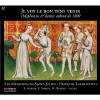Texte paru dans: / Appeared in:

Fanfare Magazine: 37:3 (01-02/2014)
Pour
s'abonner / Subscription information
Les abonnés à Fanfare Magazine ont accès aux archives du
magazine sur internet.
Subscribers to Fanfare Magazine have access to the archives of the magazine
on the net.
Alpha
189

Consultez toutes les évaluations recensées pour ce cd
~~~~ Reach all the evaluations located for this CD
This album for the most part catches a literary tradition in decline, and the lengthy heyday of a musical one.
The literary tradition is that of the energetic shepherd Robin and his coy shepherdess-sweetheart Marion, whose origin is ascribed to the Gascon Marcabru, one of the earliest troubadours. (In Music of the Troubadors, Elizabeth Aubrey states that he flourished around 1129–1149. Of 44 extant song texts of his, four survive with their melodies.) Marcabru in effect created a game of social and sexual interaction, one in which the pastoral pair either address one another, or the singer engages in dialogue with one of them—often as a knight flirting with Marion. This allowed for a range of reactions that, while embracing the pastoral myth (which would come to its height six centuries later), avoided the far more formulaic one of courtly love. Marcabru’s structure was open-ended enough to become immensely popular. (It would cross to England in its later years, finding its greatest literary success in the form of an ironically incomplete play by Ben Jonson, The Sad Shepherd, and in its gradual folding into the Robin Hood legend. That’s where Maid Marion comes from.) Not everything on this release relies upon Robin and Marion, but they do form a recurring theme throughout the program.
The musical tradition in turn is the so-called formes fixes, a group of forms for secular vocal music that stayed in use for nearly two centuries. These were the ballade, the rondeau, and the virelai, each with its own structure built upon repetition and variation. On this recording, we have four ballades, three rondeaus, and nine virelais; and although the liner notes lay out very specific patterns for each, in practice they varied greatly. (The ballade is listed as AAB or AABB, for instance, but one not included on this record, Dufay’s subtle Resveillies vous et faites chiere lye, follows AaBC.) There are also instrumental pieces, along with a vigorous, earlier motet—its three parts sung simultaneously to three different texts, as was the style of the day—and a chace, one of those exuberant canons that would spawn programmatic pieces over several hundred years in everything from madrigals about love to imitations of the confusion of war.
I previously wrote about François Lazarevitch and his ensemble, Les Musiciens de Saint-Julien, that they were one of those early music performing groups who “like two others in the Alpha stable, Le Poème Harmonique and Les Witches, combine classical and folk traditions in the performance of ‘lowbrow’ airs and dances.” That was in reference to a recording of music from around 1600. Their move here to a much earlier period also means making a series of executive decisions regarding unwritten performance practices. True to form, they opt for a rich tapestry of instruments, including some today associated almost exclusively with folk music: a bombard, bagpipes, medieval harp, medieval lute, shawm, rebec, sackbut, vieles, up to three male voices, and a range of percussion. They also arrange the music for greater variety, sometimes playing a vocal piece as an instrumental, or introducing a piece with several verses played first as an instrumental—Ciconia’s Gli atti col Dançar being an example of the latter. Les Musiciens de Saint-Julien varies its instrumentation according to its material, and presents themes of greater emotional disparity than courtly love would have supported. The arrangements, though colorful, never go overboard into the meretricious.
Current
scholarship inclines to belief that the early troubadours sang without
accompaniment, and that later ones may have been accompanied by a single
instrument, but our knowledge of this period’s musical performances is
woefully inadequate. It’s also extremely unlikely in any case that there was
one hard and fast rule adhered to in all courts, in all places. But even if
there was such a rule, it would have no effect on the vitality of these
performances, which owes much to French folk traditions. The singing (in
particular by tenor Simone Sorini, who also takes up the lute) is expressive
and, along with the instrumentals, fully expert. In short, this is an
expressively wide-ranging program that’s delightfully performed by
Lazarevitch and Les Musiciens. Recommended.
Fermer la fenêtre/Close window
Cliquez l'un ou l'autre
bouton pour découvrir bien d'autres critiques de CD
Click either button for many other reviews


